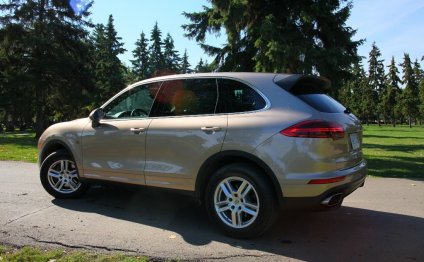
Porsche Cayenne V6 Review
 Displacing 3, 598 cubic centimeters, the direct-injected 10.6-degree V6 features an iron block and aluminum cylinder heads. Unlike the all-aluminum 90-degree V6 when you look at the Panamera, the Volkswagen narrow-angle "VR6" powerplant won't have balance shafts (our calibrated rears state the Porsche V6 is slightly smoother). Even though the Volkswagen variant makes 280 horse power, Porsche engineers tweaked the tuning and gifted the engine with a brand new intake manifold to personalize it for task in Cayenne. The result is a bump to 300 horsepower (at 6, 300 rpm) and 295 lb-ft of torque (at 3, 000 rpm). Bolted toward back for the motor is a standard 6-speed handbook transmission (yes, a manual transmission). We did not get to be able to check it out, as our test designs were fitted with Porsche's excellent brand new eight-speed Tiptronic S automated transmission. In both situations, power is delivered to all four corners associated with the SUV through an electronically-controlled all-wheel drive system. There is absolutely no low range case anymore, as Porsche claims the lower gears tend to be adequate for serious off road vacation. Even with six-cylinder energy, the Cayenne is ranked to tow the same 7, 700-pound trailer as its siblings.
Displacing 3, 598 cubic centimeters, the direct-injected 10.6-degree V6 features an iron block and aluminum cylinder heads. Unlike the all-aluminum 90-degree V6 when you look at the Panamera, the Volkswagen narrow-angle "VR6" powerplant won't have balance shafts (our calibrated rears state the Porsche V6 is slightly smoother). Even though the Volkswagen variant makes 280 horse power, Porsche engineers tweaked the tuning and gifted the engine with a brand new intake manifold to personalize it for task in Cayenne. The result is a bump to 300 horsepower (at 6, 300 rpm) and 295 lb-ft of torque (at 3, 000 rpm). Bolted toward back for the motor is a standard 6-speed handbook transmission (yes, a manual transmission). We did not get to be able to check it out, as our test designs were fitted with Porsche's excellent brand new eight-speed Tiptronic S automated transmission. In both situations, power is delivered to all four corners associated with the SUV through an electronically-controlled all-wheel drive system. There is absolutely no low range case anymore, as Porsche claims the lower gears tend to be adequate for serious off road vacation. Even with six-cylinder energy, the Cayenne is ranked to tow the same 7, 700-pound trailer as its siblings.
Apart from the lacking cylinders, the six-cylinder Cayenne models in addition wear somewhat smaller standard brake system. The fronts tend to be six-piston aluminum monobloc calipers (painted black) on 13.78-inch metal rotors, even though the rears are four-piston calipers on 13-inch metal rotors. Porsche's composite ceramic brake (PCCB) system is optional (and apparent to any or all within vision with its huge metallic rotors and yellowish calipers). Steel springs and gas pressurized dampers tend to be standard, with environment suspension and Porsche Active Suspension Management (PASM) optional.
Recognizing the wheel/tire/brake plans are upgradeable on all trim amounts, it's tough to tell the designs aside without examining the scripted badge regarding hatch or catching a glimpse of front. It is the nostrils that varies. The Cayenne Turbo wears an aggressively large grille and intake, as the normally-aspirated models share smaller grilles (the V8 model is finished in black colored, although the V6 receives an aluminized finish). The Cayenne V6 also sports twin brushed stainless egg-shaped fatigue outlets, much like the Panamera V6.
The less heavy powertrain takes care of at the machines. The Cayenne SUV weighs just 4, 399 weight, undercutting its sibling Cayenne Turbo by almost 400 weight and making your competition lined up at Jenny Craig, with all the Mercedes-Benz ML350 arriving 330 pounds heavier in addition to six-cylinder BMW X5 lugging around an extra 531 weight.

With all the type in our left hand, we climb into a nondescript six-cylinder Cayenne using 19-inch wheels (covered with 265/50YR19 Pirelli tires). The all-new interior mirrors the elegant styling of Panamera sedan – extremely upscale and meticulously finished from the breathtaking lumber and aluminum accents into leather stitching on dashboard. The chair and controls tend to be infinitely flexible and outward presence is great, even though the back up digital camera helps.
As previously mentioned in our first operating impressions earlier, the Cayenne platform is extremely enjoyable to-drive. Its operating mannerism tend to be more "big sedan" than oversized 'ute, indicating the brake system and steering are attentive to the motorist's inputs, not simply taking recommendations. It does not feel nearly since ponderous because the Audi Q7 or because heavy whilst the BMW X5 when touring tight town streets.
Acknowledging so it has actually less size to haul around than its forerunner, the 0-60 mph sprint now takes about 7.5 seconds, placing it decidedly mid-pack among its competitive portion. Above all, with excellent gearing down reasonable, you won't skip the V8 or Turbo under 45 mph given that six-cylinder Cayenne moves off the line enthusiastically due to the aforementioned eight-speed Tiptronic tranny.
A lot more than quite happy with its overall performance around town, we steered the six-cylinder Cayenne towards the Autobahn to test its powertrain under much more demanding problems. As steady at large rates as it's sitting nonetheless in a parking lot, the SUV easily presented velocities between 80 and 110 miles per hour. As expected, it does lose the majority of its stamina as the speed increases over 90 miles per hour (e.g., the Cayenne Turbo rockets to 125 mph in about 13 seconds, while the Cayenne V6 does it in a longish 35 seconds). With persistence, and a long available stretch of roadway, we were able to coax it to an indicated 134 miles per hour, although Porsche promises it's going to run 143 miles per hour if because of the opportunity. When it came time for you to bleed from the rate, the typical brakes had been more than to the task.
INTERESTING VIDEO



Share this Post
Related posts
Porsche Cayenne 2015 Review
What is Brand New for 2015 For 2015, the Porsche Cayenne receives significant modifications. The Cayenne S now features a…
Read More2015 Porsche Cayenne s Review
Oh, Porsche. In the same way the dirt settles across 911 GT3isn manual gearbox kerfuffle, the Germans went and yanked the…
Read More










